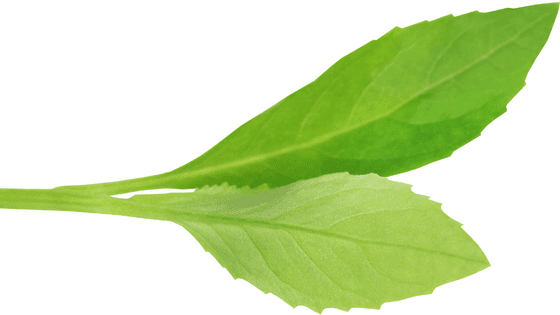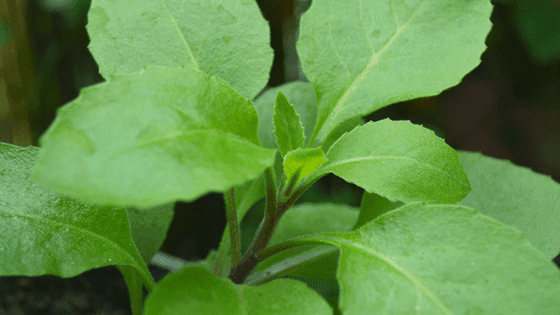If you’re looking for a beautiful plant with health benefits, check out Longevity spinach plants. They are hearty, easy to grow, and the leaves make delicious and healthy recipes.
Table of Contents
Longevity Spinach Overview
The Longevity spinach plant is more than just a plant; it’s a vegetable too. Originating in Southeast Asia, Africa, and Malaysia, the plant loves tropical climates and has some succulent tendencies.
The plant’s scientific name is Gyunara procumbens, a part of the Asteraceae family. Its genus is Gynura. Its most common name is Longevity spinach, but other names it goes by include Moluccan spinach, Daun Dewa, Sambung nyawa, and Sanbungai plant.
Another common variety of Longevity spinach is Okinawan spinach. You can tell the difference because this variation has pointy green and purple leaves and is primarily grown in China, whereas longevity spinach has round leaves that are green on the top and purple underneath.
| Family | Asteraceae |
| Genus | Gynura |
| Origin | Southeast Asia and Africa |
| Sunlight | Direct sunlight and partial shade |
| Watering | Weekly, doesn’t require a lot of water |
| Soil | Normal, good quality soil |
| Temperature | Prefers 70 degrees and higher |
| Potting | Terra cotta pots with drainage holes |
| Pests and Diseases | Aphids and beetles |
| Toxicity | Not toxic |
Longevity Spinach Features
The Longevity spinach plant doesn’t get very tall. Most plants are 12 inches high, with the smallest plant measuring 6 inches. The plant, as you probably guessed, is primarily green, but as we said above, the underside of its leaves turn purple.
In the spring, the Longevity spinach plant has flowering heads that are a beautiful orange. The flowers grow on the tips of the stems, making them an angiosperm.
This plant makes an excellent ground cover as the Longevity spinach vines tend to creep along the ground rather than climbing, creating a thick ground cover that’s almost shrub-like.
The Longevity spinach plant leaves are smooth, typically round or oval. They typically measure about one inch wide and 3 inches long.
A nice feature of the Longevity spinach is that it isn’t toxic to humans or pets. In fact, the opposite is true since the plant is not only edible but also healthy for humans and pets as it provides many health benefits.

Longevity Spinach Care Guide
Like every plant, properly caring for Longevity spinach is the key to lush growth and a beautiful plant that provides health benefits.
Ideal Growing Place
You can grow Longevity spinach indoors or outdoors. If you keep it indoors, ensure it gets adequate sunlight because it loves the light but not too much direct light. If you keep it indoors, ensure it’s not near any drafts from the A/C, furnace, or windows. If you can’t get enough sunlight in your home, a grow light can help the longevity spinach thrive.
In the spring, the plant grows beautiful orange flowers that smell amazing and attract butterflies and hummingbirds.
The plant is safe to plant after the last frost, but keep in mind it prefers warmer temperatures. Before taking it outdoors, make sure the threat of frost is over. If you planted them in the ground, cover the plants with frost cloths to prevent damage.
Water
Because this plant is a semi-succulent vining plant, it holds water well, so there’s no need to overwater it. Instead, water it weekly during the warmer months and less frequently during colder months. In addition, the roots of this plant run deep, so it doesn’t rely only on water from the surface to stay alive; it can also get water from sources beneath the soil.
Sunlight
The Longevity spinach plant loves the sun, but not too much. It thrives best in partial shade. If it has access to direct sun in the morning hours and shade later in the day, it will have the perfect amount of sunlight.
Temperature
As a tropical plant, you’ll have the best luck growing Longevity spinach in warmer temperatures. It loves temperatures of 70 degrees or higher when outdoors and does well in most indoor temperatures too.
Soil
When growing Longevity spinach, it needs loose soil with proper drainage. If the roots soak in water too long, it can lead to root rot and prematurely kill your plant. The good news is, though, you don’t need an expensive specialty soil; this succulent plant does well with most basic soil products.
Humidity
As you care for your Longevity spinach plant, one thing you don’t have to worry about much is the humidity levels. This is one plant that doesn’t need high humidity levels. Unlike some plants, misting the Longevity spinach leaves with water can hurt the plant rather than help it.
Fertilizer
Typically, the Longevity spinach plant doesn’t need fertilizer if planted in high-quality soil. However, if it’s not getting the nutrients it needs or looks sick, a fertilizer high in nitrogen can keep it healthy. You only need to fertilize a few times a year, though.
Pinching/Pruning
You only need to pinch or prune the Longevity spinach plant when ready to use it. You can pinch the leaves off the stem when harvesting your plant by pulling gently. You can also remove leaves from a pruned stem if you prefer.
If you keep your plant indoors, pruning it often will keep it looking its best and provide you with the most healthy leaves.
Potting and Re-potting
It’s best to use terra cotta pots for your plant because unglazed pots help eliminate excess water. However, no matter the pot you use, make sure it’s small enough. If a pot is too large, you cannot control the moisture, which can hurt your plant. Also, ensure the pot has proper drainage.
Growth Zone
Ideally, the Longevity spinach plant grows best in zones 9 – 11 but can thrive in just about any zone. The key is to bring it in during extreme cold and frost. If you grow it outdoors in any zone except 9 – 11, plant it in a pot and bring it indoors in the colder months.
You May Also Like: How To Use A Lawn Spreader The Correct Way
Common Pests, Toxins, Diseases & Other Problems
Like most vegetable plants, the Longevity spinach plant deals with pests, including aphids and beetles. Other issues the plant faces are a lack of airflow and fungal infections. If you notice your plant has discolored, yellow, or brown leaves, prune the affected area immediately to avoid affecting the rest of the plant.
Propagation
You can propagate the Longevity spinach plant through stem cuttings or a rooted stem. Both options provide a healthy and beautiful plant for yourself or to give as gifts.
Stem cuttings
- Cut off 10 – 18 inches of a stem, cutting below a leaf
- Remove most of the leaves, leaving two or three at the top of the stem
- Place the stem cutting into a vase of water
- Let it sit for up to two weeks
- Once you see roots developing, plant them in the soil
- Plant the new plant cuttings daily for the first couple of weeks
Rooted Stem
- Separate a rooted plant into smaller sections, carefully removing one section
- Plant the stem in your new area
Longevity Spinach Mature Timeline
It takes approximately two weeks for the roots of the Longevity spinach plant to grow from a stem cutting. From there, the plant grows relatively quickly since it only grows to about 12 inches.
Harvesting
You can harvest Longevity spinach leaves to feed your family, including your furry friends. It doesn’t take any special skills. Simply pinch the leaves and pull, using them in your favorite recipes.

Longevity Spinach FAQ
Want to know more? Check out these frequently asked questions about the Longevity spinach.
Why Is It Called Longevity Spinach?
The name Longevity spinach came from the benefits of the plant’s leaves. It’s known as the ‘leaf of the gods.’ Each leaf is high in protein, and the plant is easy to propagate, allowing you to share the benefits of this beautiful plant with others.
What Are Some Longevity Spinach Benefits?
The Longevity spinach plant offers many health benefits, including lower blood pressure and cholesterol. It also has high antioxidant, anti-inflammatory, and antimicrobial properties, which may help with ulcers or weight loss.
What Are Some Longevity Spinach Recipes?
Some great ways to use Longevity spinach leaves are crushed up in teas or smoothies, added to your favorite soups, replacing lettuce on your sandwich, added to your salads, or your favorite sauces. You can eat it cooked or raw. When cooked, it shrinks like regular spinach, so cook enough to feed your crowd.
How to Grow Longevity Spinach?
Growing Longevity spinach is easy. It doesn’t need a lot of care or special soil. Make sure it has enough sunlight, but not too much, water it occasionally, and prune it when the leaves look out of control, and you have a healthy and beautiful plant.
How to Grow Longevity Spinach From Cuttings?
It’s easy to grow Longevity spinach from stem cuttings. Just cut a stem with at least one leaf on it, and place it in water. After a few weeks, it will grow roots, and you can plant it in the ground. It may require extra watering for the first week or so, but after that, it’s easy to maintain the plant.
Can You Keep Longevity Spinach as a Potted Plant Year Round?
If you live in an area where it doesn’t frost or get cold, you can leave it planted in the ground year-round. However, if you live in an area where it gets cold and there’s frost, you should pot the plant and bring it in before it frosts as it doesn’t tolerate freezing temperatures.
Is Longevity Spinach a Perennial or Annual?
Longevity spinach is a perennial, which means it comes back every year.
How Does Longevity Spinach Taste?
Like regular spinach, there’s not much of a taste to the spinach leaves. The leaves can resemble okra when you cook it, but there isn’t much taste. It’s more about the health benefits.
Why Are the Leaves of My Longevity Spinach Plant Yellow?
Yellow leaves often mean the plant lacks nitrogen. A quick fix is to add liquid organic fertilizer high in nitrogen to get the leaves back to their normal color.
Why Do the Leaves of My Longevity Plant Have Small Speck on Them?
Specks on Longevity spinach’s leaves are usually a sign of a pest infestation. Aphids are usually the culprit as they suck the leave’s nectar, hide underneath the leaves, and leave a sticky liquid behind. To get rid of them, spray the leaves with water and make sure they get enough sun.
Why Does It Look Like My Longevity Spinach Leaves Have White Tunnels Running Through Them?
A leafminer larvae infestation will cause white tunnels on your plant’s leaves. First, quickly remove the affected leaves to avoid the damage from spreading to the entire plant. Next, cover the plant to keep adult flies from attacking it.
How Much Longevity Spinach Should You Eat?
At the most, eat 10 – 15 leaves a day, but when you start, consider having only five or so leaves to acquire the taste and texture.
Is Longevity Spinach Real Spinach?
Despite its name, Longevity spinach isn’t spinach. It’s a succulent that you can eat the leaves of, but it’s not the typical vegetable you get at the grocery store.
Is It Safe to Eat Longevity Spinach Raw?
You can eat the Longevity spinach leaves raw, just like you would spinach. It’s good on sandwiches and salads.
Can You Eat Longevity Spinach Stems?
You can eat the stems of the Longevity spinach plant. They resemble celery and can add a healthy crunch to your recipes.
How Old Does Longevity Spinach Have to Be Before They Bloom?
Longevity spinach blooms in the spring. As long as its roots have grown to their maximum height of 6 – 12 inches, it will bloom flowers.
What Does Longevity Spinach Smell Like?
The plant has a lovely and pleasant smell when its flowers bloom in the spring.
Where Can I Buy Longevity Spinach Seeds?
You can find Longevity spinach seeds online at specialty nurseries or buy propagated plants for even faster growth. The stem cuttings are much easier to find than seeds.
What Is the Longevity Spinach Toxicity to Pets and Humans?
Unlike most plants, you don’t have to worry about the plant’s toxicity. While you should keep consumption to a minimum, the leaves are typically healthy. If a child or pet consumes too many leaves, though, you may want to seek medical attention.
The Bottom Line
Longevity spinach grows fast, is easy to take care of, and offers the benefit of the ability to be eaten fresh. In addition, this semi-succulent plant propagates well, making it easy to give it as gifts, and it has incredible health benefits.
Last Updated on October 4, 2022 by Gustaf Johansson




